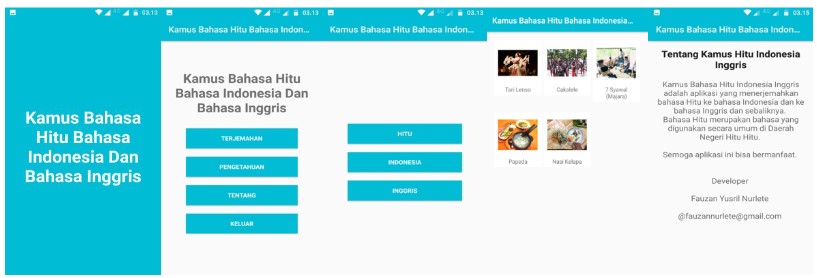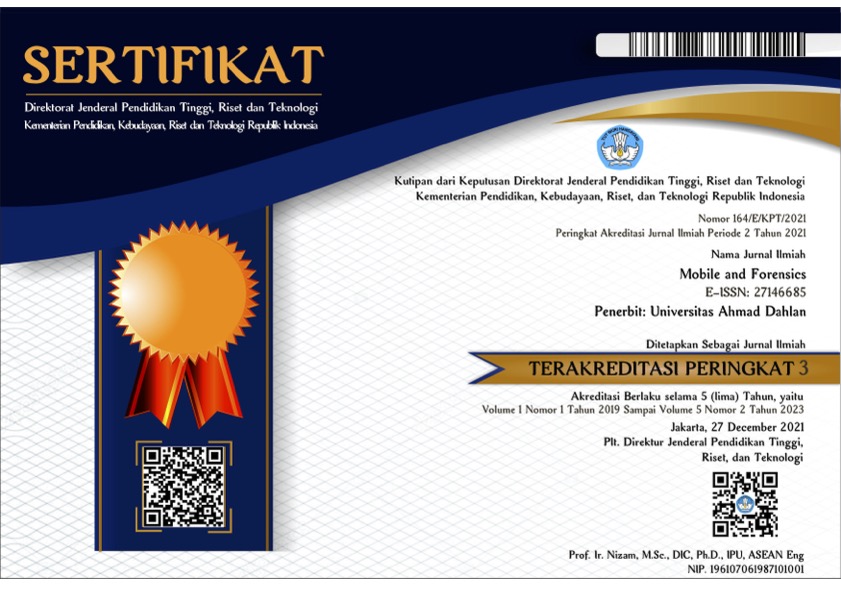Mobile Dictionary For Hitu Ethnic Language
DOI:
https://doi.org/10.12928/mf.v3i1.998Keywords:
Dictionary, Language, Negeri Hitu, Mobile, EthnicsAbstract
Indonesians have many diverse ethnic groups. Each tribe has different traditions and cultures. As with language, each tribe has a different local language to communicate and interact with their community and environment. Hitu is one of the villages (Negeri) on Ambon Island, Central Maluku Regency. People in Tanah Hitu communicate every day using the Hitu language. Hituese is one of the local languages in Indonesia. The Hitu Country dictionary application is a mobile-based application that can make it easier for the people of Hitu Village to find translations from Hitu - Indonesian - English or vice versa. This is because many foreign and domestic tourists visit Hitu Village. People in Hitu can certainly speak Indonesian, but not all are able to speak it fluently. Therefore, this dictionary was created to facilitate the community in Hitu. This mobile application can display vocabulary translations that can be searched from Hitu to Indonesian and Indonesian to Hitu or vice versa. This dictionary will use Android-based mobile devices and will also take advantage of current developments that are very sophisticated. The Hitu dictionary application will be easy to carry anywhere and can be accessed every day.
References
E. Kidd, S. Donnelly, and M. H. Christiansen, ‘Individual Differences in Language Acquisition and Processing’, Trends in Cognitive Sciences, vol. 22, no. 2, pp. 154–169, Feb. 2018, doi: 10.1016/j.tics.2017.11.006.
Dr. M. R. Ahmadi and Guilan University, Guilan, Iran, ‘The Use of Technology in English Language Learning: A Literature Review’, IJREE, vol. 3, no. 2, pp. 115–125, Jun. 2018, doi: 10.29252/ijree.3.2.115.
N. Matentzoglu, J. Malone, C. Mungall, and R. Stevens, ‘MIRO: guidelines for minimum information for the reporting of an ontology’, J Biomed Semant, vol. 9, no. 1, p. 6, Dec. 2018, doi: 10.1186/s13326-017-0172-7.
N. Chater and M. H. Christiansen, ‘Language acquisition as skill learning’, Current Opinion in Behavioral Sciences, vol. 21, pp. 205–208, Jun. 2018, doi: 10.1016/j.cobeha.2018.04.001.
C. Coombe, H. Vafadar, and H. Mohebbi, ‘Language assessment literacy: what do we need to learn, unlearn, and relearn?’, Lang Test Asia, vol. 10, no. 1, p. 3, Dec. 2020, doi: 10.1186/s40468-020-00101-6.
R. Basu, ‘The Problematic Influences Of First Language Culture On Esl And Modes To Overcome The Same’, International Journal of English Learning & Teaching Skills, vol. 1, no. 1, pp. 62–65, Aug. 2018, doi: 10.15864/ijelts.1110.
H. Xie, H.-C. Chu, G.-J. Hwang, and C.-C. Wang, ‘Trends and development in technology-enhanced adaptive/personalized learning: A systematic review of journal publications from 2007 to 2017’, Computers & Education, vol. 140, p. 103599, Oct. 2019, doi: 10.1016/j.compedu.2019.103599.
C. Lefebvre et al., ‘Searching for and selecting studies’, in Cochrane Handbook for Systematic Reviews of Interventions, 1st ed., J. P. T. Higgins, J. Thomas, J. Chandler, M. Cumpston, T. Li, M. J. Page, and V. A. Welch, Eds. Wiley, 2019, pp. 67–107. doi: 10.1002/9781119536604.ch4.
F.-X. Geiger and I. Malavolta, ‘Datasets of Android Applications: a Literature Review’, arXiv:1809.10069 [cs], Sep. 2018, Accessed: Feb. 11, 2022. [Online]. Available: http://arxiv.org/abs/1809.10069
Y. S. Yang, G. W. Ryu, and M. Choi, ‘Methodological Strategies for Ecological Momentary Assessment to Evaluate Mood and Stress in Adult Patients Using Mobile Phones: Systematic Review’, JMIR Mhealth Uhealth, vol. 7, no. 4, p. e11215, Apr. 2019, doi: 10.2196/11215.
A. Mildon and D. Sellen, ‘Use of mobile phones for behavior change communication to improve maternal, newborn and child health: a scoping review’, Journal of Global Health, vol. 9, no. 2, p. 020425, Dec. 2019, doi: 10.7189/jogh.09.020425.
W. Marler, ‘Mobile phones and inequality: Findings, trends, and future directions’, New Media & Society, vol. 20, no. 9, pp. 3498–3520, Sep. 2018, doi: 10.1177/1461444818765154.
L. M. Verhagen, R. de Groot, C. A. Lawrence, J. Taljaard, M. F. Cotton, and H. Rabie, ‘COVID-19 response in low- and middle-income countries: Don’t overlook the role of mobile phone communication’, International Journal of Infectious Diseases, vol. 99, pp. 334–337, Oct. 2020, doi: 10.1016/j.ijid.2020.07.069.
A. Moradi and M. Nushi, ‘Google Dictionary: A Critical Review’, Issues and Trends in Learning Technologies, vol. 8, no. 1, Jun. 2020, doi: 10.2458/azu_itlt_v8i1_nushi.
Y. Ying, T. N. Mursitama, Theresia, and Mariana, ‘Welcoming Chinese investors in Indonesia: improving the competency of professional Indonesian-Mandarin translator’, IOP Conf. Ser.: Earth Environ. Sci., vol. 126, p. 012090, Mar. 2018, doi: 10.1088/1755-1315/126/1/012090.
R. A. Wijaya, E. M. Kusumaningtyas, and A. Barakbah, ‘Knowledge Based Chatbot with Context Recognition’, in 2019 International Electronics Symposium (IES), Surabaya, Indonesia, Sep. 2019, pp. 432–438. doi: 10.1109/ELECSYM.2019.8901559.
M. N. N. Sitokdana, R. Tanone, and P. F. Tanaem, ‘Digitalization of The Local Language Dictionary of Pegunungan Bintang’, Procedia Computer Science, vol. 161, pp. 49–56, 2019, doi: 10.1016/j.procs.2019.11.098.
R. Ellen, ‘Pottery production and trade in the Banda zone, Indonesia: The Kei tradition in its spatial and historical context’, Indonesia and the Malay World, vol. 47, no. 138, pp. 133–159, May 2019, doi: 10.1080/13639811.2019.1582862.
A. H. Nasution and Y. Murakami, ‘Visualizing Language Lexical Similarity Clusters: A Case Study of Indonesian Ethnic Languages’, Journal of Data Science and Its Applications, pp. 45-59 Pages, Nov. 2019, doi: 10.34818/JDSA.2019.2.23.
B. Kirchweger and J. M. Rollinger, ‘A Strength-Weaknesses-Opportunities-Threats (SWOT) Analysis of Cheminformatics in Natural Product Research’, in Progress in the Chemistry of Organic Natural Products 110, vol. 110, A. D. Kinghorn, H. Falk, S. Gibbons, J. Kobayashi, Y. Asakawa, and J.-K. Liu, Eds. Cham: Springer International Publishing, 2019, pp. 239–271. doi: 10.1007/978-3-030-14632-0_7.

Downloads
Published
Issue
Section
License
Copyright (c) 2021 Fauzan Yuusril Nurlete, Agus Fatkhurohman

This work is licensed under a Creative Commons Attribution-ShareAlike 4.0 International License.
Start from 2019 issues, authors who publish with JURNAL MOBILE AND FORENSICS agree to the following terms:
- Authors retain copyright and grant the journal right of first publication with the work simultaneously licensed under a Creative Commons Attribution License (CC BY-SA 4.0) that allows others to share the work with an acknowledgment of the work's authorship and initial publication in this journal.
- Authors are able to enter into separate, additional contractual arrangements for the non-exclusive distribution of the journal's published version of the work (e.g., post it to an institutional repository or publish it in a book), with an acknowledgment of its initial publication in this journal.
- Authors are permitted and encouraged to post their work online (e.g., in institutional repositories or on their website) prior to and during the submission process, as it can lead to productive exchanges, as well as earlier and greater citation of published work.

This work is licensed under a Creative Commons Attribution-ShareAlike 4.0 International License.











 Mobile and Forensics (MF)
Mobile and Forensics (MF)